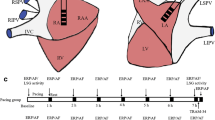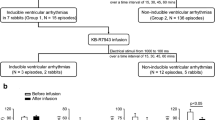Abstract
As a special focus in initiating and maintaining atrial fibrillation (AF), cardiomyocytes in superior vena cava (SVC) have distinctive electrophysiological characters. In this study, we found that comparing with the right atrial (RA) cardiomyoctyes, the SVC cardiomyoctyes had longer APD90 at the different basic cycle lengths; the conduction block could be observed on both RA and SVC cardiomyoctyes. A few of SVC cardiomyoctyes showed slow response action potentials with automatic activity and some others showed early afterdepolarization (EAD) spontaneously. Further more, we found that there are nonselective cation current (INs) in both SVC and RA cardiomyocytes. The peak density of INs in SVC cardiomyocytes was smaller than that in RA cardiomyocytes. Removal of extracellular divalent cation and glucose could increase INs in SVC cardiomyocytes. The agonist or the antagonist of INs may increase or decrease APD. To sum up, some SVC cardiomyocytes possess the ability of spontaneous activity; the difference of transmembrane action potentials between SVC and RA cardiomyocytes is partly because of the different density of INs between them; the agonist or the antagonist of INs can increase or decrease APD leading to the enhancement or reduction of EAD genesis in SVC cardiomyocytes. INs in rabbit myocytes is fairly similar to TRPC3 current in electrophysiological property, which might play an important role in the mechanisms of AF.
Similar content being viewed by others
References
Haissaguerre M, Jais P, Shah DC, et al. Right and left atrial radiofrequency catheter therapy of paroxysmal atrial fibrillation. J Cardiovasc Electrophysiol, 1996, 7: 1132–1144, 8985802, 10.1111/j.1540-8167.1996.tb00492.x, 1:STN:280:ByiC3sfotFw%3D
Jais P, Haissaguerre M, Shah DC, et al. A focal source of atrial fibrillation treated by discrete radiofrequency ablation. Circulation, 1997, 95: 572–576, 9024141, 1:STN:280:ByiC2snmtVY%3D
Haissagurre M, Jais P, Shah DC, et al. Spontaneous initiation of atrial fibrillation by ectopic beats originating in the pulmonary veINs. N Engl J Med, 1998, 339: 659–666, 10.1056/NEJM199809033391003
Bode F, Sachs F, Franz M R. Tarantula peptide inhibits atrial fibrillation. Nature, 2001, 409: 35–36
William J Crumb Jr, John D, et al. Description of nonselective cation current in human atrium. Circulation Res, 1995, 77: 950–956
Terasawa K, Nakajima T, Iida H, et al. Nonselective cation currents regulate membrane potential of rabbit coronary arterial cell modulation by lysophosphatidylcholine. Circulation, 2002, 106: 3111–3119, 12473560, 10.1161/01.CIR.0000039345.00481.1D
Macianskiene R, Matejovic P, Sipido K, et al. Modulation of extracellular divalent cation-inhibitied nonselective conductance in cardiac cells by metabolic inhibition and by oxidants. J Mol Cell Cardiol, 2001, 33: 1372–1385, 10.1006/jmcc.2001.1401
Mubagwa K, Stengl M, Flameng W. Extracellular divalent cations block a cation non-selective conductance unrelated to channels in rat cardiac muscle. J Physiol, 1997, 502: 235–247,9263906, 10.1111/j.1469-7793.1997.235bk.x, 1:CAS:528:DyaK2sXlt1Sjurg%3D
Minke B, Cook B. TRP channel proteins and singal transduction. Physiol Rev, 2002, 82: 429–472, 11917094, 1:CAS:528:DC%2BD38XjtFOnsL8%3D
Liu T F. Early afterdepolarization in myocardium and its clinical implication. Meth Fin Exp Clin Pharmacol, 1992, 14(3): 157–163, 1:STN:280:By2A38nksFU%3D
Yeh H I, Lai Y J, Lee S H, et al. Heterogeneity of myocardial sleeve morphology and gap junction in canine superior vena cava. Circulation, 2001, 104: 3152–3157,11748116, 10.1161/hc5001.100836, 1:STN:280:DC%2BD38%2FgtVSrtg%3D%3D
Minke B, Hardie R C. Genetic dissection of Drosophila phototransduction. In: Stavenga D G, van der Hope D J N, Pugh E, eds. Molecular Mechanisms in Visual Transduction. Amsterdam: Elsever-North Holland, 2000. 449–525,10.1016/S1383-8121(00)80012-3
Minke B, Selinger Z. The roles of trp and calcium in regulating photoreceptor function in Drosophila. Curr Opin Neurobiol, 1996, 6: 459–466, 8794093, 10.1016/S0959-4388(96)80050-X, 1:CAS:528:DyaK28Xlsleltrg%3D
Montell C. Visual transduction in Drosophila. Annu Rev Cell Dev Biol, 1999, 15: 231–268, 10611962, 10.1146/annurev.cellbio.15.1.231, 1:CAS:528:DC%2BD3cXhtVSnur0%3D
Scott K, Zuker C. Trp, Trpl and trouble in photoreceptor cells. Curr Opin Neurobiol, 1998, 8: 383–388, 9687362, 10.1016/S0959-4388(98)80065-2, 1:CAS:528:DyaK1cXktlCisr8%3D
Vannier B, Zhu X, Brown D, et al. The membrane topology of human transient receptor potential 3 as inferred from glycosulation-scanning mutagennesis and epitope immunocytochemistry. J Biol Chem, 1998, 273: 8675–8679, 9535843, 10.1074/jbc.273.15.8675, 1:CAS:528:DyaK1cXis1eltr0%3D
Dohke Y, Oh Y S, Ambudkar I S, et al. Biogenesis and topology of the transient receptor potential Ca2+ channel TRPC1. J Biol Chem, 2004, 279: 12242–12248, 14707123, 10.1074/jbc.M312456200, 1:CAS:528:DC%2BD2cXitl2hu7c%3D
Wedel B J, Vazquez G, Mckay R R, et al. A calmodulin/inositol 1,4,5-trisphosphate (IP3) receptor-binding region targets TRPC3 to the plasma membrane in a calmodulin/IP3 receptor-independent process. J Biol Chem, 2003, 278: 25758–25765, 12730194, 10.1074/jbc.M303890200, 1:CAS:528:DC%2BD3sXlt1Cls7w%3D
Vazquez G, Wedel B J, Aziz O, et al. The mammalian TRPC cation channels. Biochim Biophys Acta, 2004, 1742: 21–26, 15590053, 10.1016/j.bbamcr.2004.08.015, 1:CAS:528:DC%2BD2cXhtVKktrzO
Song Y D, Yang X C, Liu T F, et al. Nonselective cation current in rabbit ventricular myocytes. Methods Find Exp Clin Pharmacol, 2005, 27(7): 1–7
Faiconnier J, Lanner J T, Sultan A, et al. Insulin potentiates TRPC3-mediated cation currents in normal but not in insulin-resistant mouse cardiomyocytes. Cardiovas Res, 2007, 73: 376–385, 10.1016/j.cardiores.2006.10.018
Montell G. The TRP superfamily of cation channels. Sci STKE, 2005, 22(272): re3, 10.1126/stke.2722005re3
Author information
Authors and Affiliations
Corresponding author
Rights and permissions
About this article
Cite this article
Wang, P., Yang, X., Liu, X. et al. The characteristics of action potential and nonselective cation current of cardiomyocytes in rabbit superior vena cava. SCI CHINA SER C 51, 326–335 (2008). https://doi.org/10.1007/s11427-008-0043-7
Received:
Accepted:
Published:
Issue Date:
DOI: https://doi.org/10.1007/s11427-008-0043-7




